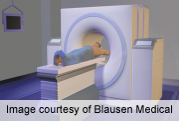
MONDAY, Dec. 3 (HealthDay News) — Increasing numbers of U.S. children undergo diagnostic imaging tests such as MRIs and CT scans, and higher-radiation tests account for a growing proportion of these procedures, researchers report.
Their study of 2001-2009 insurance claims in southern California found that high-radiation procedures, which could raise the risk of cancer years later, are most commonly ordered for hospitalized children or those seen in emergency departments because of abdominal pain, headache and head injury.
Overall, physicians affiliated with a pediatric hospital in San Diego ordered 200,000 diagnostic tests using radiation for 63,000 children during the period reviewed, the researchers said. Almost 8,000 of the children had higher-radiation procedures, such as CT scans, angiography (x-ray of the inside of blood vessels) and/or fluoroscopy (moving images).
Older children and boys were more likely than younger kids and girls to undergo these tests, the study said.
“Our findings may help guide clinical practice to reduce unnecessary imaging-related radiation exposure in youth,” said lead researcher Dr. Jeannie Huang, an associate professor in the division of pediatric gastroenterology at Rady Children’s Hospital, at the University of California, San Diego. The study’s goal was to identify where most of these pediatric imaging procedures are ordered, and for which children.
“We focused in particular on diagnostic imaging procedures associated with higher ionizing radiation, including CT, fluoroscopy and angiography,” Huang said. “We found that . . . they were done mostly for gastrointestinal complaints and congenital conditions. Trauma and injuries and neurologic complaints also contributed to the use of these tests.”
The report was published online Dec. 3 and will appear in the January print edition of the journal Pediatrics.
According to the U.S. National Cancer Institute, some 5 million to 9 million CT examinations are done each year on U.S. children. Their use in children and adults has increased about eightfold since 1980, growing about 10 percent each year, the agency says.
“Despite the many benefits of CT, a disadvantage is the inevitable radiation exposure,” the agency says. Children are more sensitive to radiation exposure than adults because their bodies are still developing. Also, children have a longer life expectancy than adults, meaning more time for cancer to develop, and multiple scans further up the risk for developing cancer.
Over the past decade, awareness of the potential dangers of radiation has led children’s hospitals in the United States to limit CT scans, said Dr. Nolan Altman, chief of radiology at Miami Children’s Hospital in Florida.
“Our CT numbers are way down,” said Altman. “We are doing much less CTs than we did 10 years ago.” Many of these are being replaced by ultrasound and MRIs, which don’t use radiation, he added.
Also, manufacturers have reduced radiation doses, Altman said. “In general, the dose is 30 to 40 percent less than it used to be,” he said.
“For the average child, who has one CT scan or X-ray, parents should not be concerned,” Altman added. However, a very sick child might need multiple scans, and “then there more reasons for concern,” he said.
Imaging saves lives, said Dr. Marta Schulman, chair of the American College of Radiology Pediatric Imaging Commission. “Even if you believe the worst prophecy that you would get cancer, the chances of dying from the injury is 100 percent if you don’t do the CT scan,” she said.
Schulman said it is to be expected that most of these tests are done in the hospital, where patients are the sickest. Also, emergency department doctors don’t know a child as well as the child’s own doctor, so they need these tests to make a diagnosis, she said.
“You could turn this around and say there is less imaging done when you go to your doctor, because your doctor knows you, knows your family, knows your history,” Schulman said. “In the emergency department, they don’t have that luxury.”
The key for doctors is to carefully evaluate the patient and do the test only if it’s necessary and at the lowest possible dose of radiation, she said.
Also, proper interpretation of the results is key so that the test doesn’t need to be repeated, she said.
Parents can play a role, she added. “Parents should ask about the test and why it is needed, but they shouldn’t be so concerned that they avoid a test that is really necessary,” Schulman said.
More information
For more on radiation risks for children, visit the U.S. National Cancer Institute.

